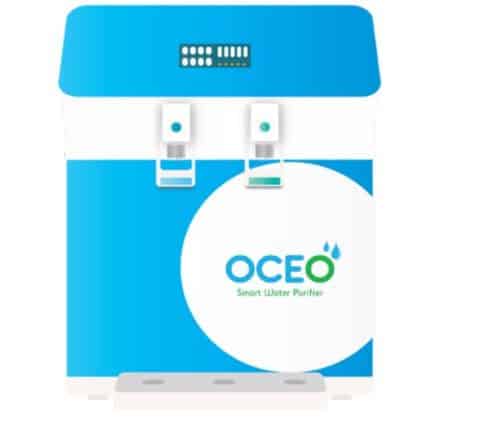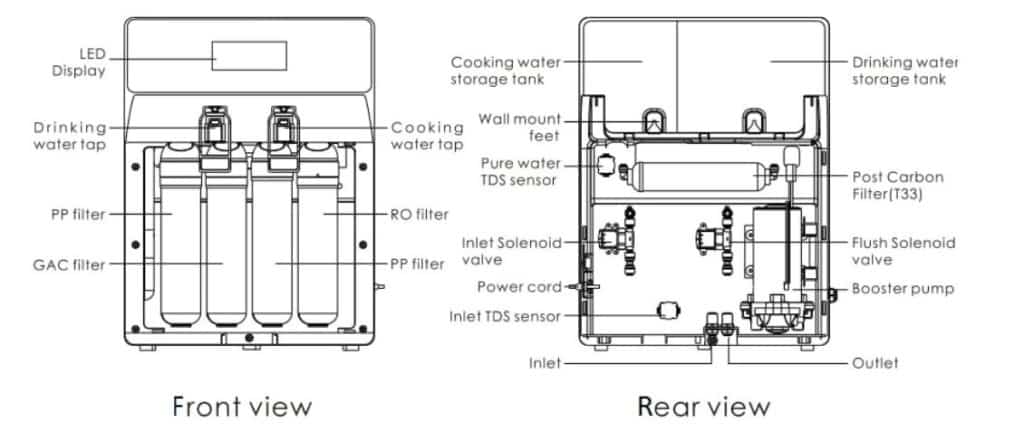Quality of drinking water is one thing that we cannot afford to compromise – not one bit. Water-borne diseases like diarrhoea, hepatitis, typhoid and cholera, or illness due to contaminants like arsenic or lead cause large-scale health hazards in India. Reports suggest that over 10,000 lives fell victim to these diseases from 2013 to 2017 in the country. To monitor water quality and reduce contamination, smart sensor-based technologies and filters are used, which often lead to high capital costs for consumers. To address this challenge, Bengaluru-based startup OCEO Water, founded by Mahendra Dantewadiya, Rajeev Krishna, Vikram Gulecha and Hasmukh Gulecha, has designed a technology that detects, purifies, measures and monitors drinking water, for zero upfront or maintenance cost and just Re.1 per litre of water consumed by the user!
The inception
The OCEO team came up with an IoT-enabled water purification-as-a-service solution looking at the heavy upfront and operational costs, maintenance hassles and the needs for improvement of existing water purifier solutions in the market.

Vikram Gulecha says, “Access to safe drinking water is a basic human right – not a privilege. Expenses for existing solutions, however, are very high. Moreover, water quality in India varies every 200 km. Some regions may have higher arsenic content in water, some may have chloride, some may contain iron, and so on. The aim of OCEO is to be able to purify water as per the specific problem existing in an area, as each contaminant requires a different approach for purification”.
The technical team at OCEO started research on the technology two and a half years back, planning a mix of filtration systems, sensor-based monitoring, cloud-based analytics along with conventional water dispensing, and innovated the smart water purification system. At the moment, OCEO is being used by many families in Bengaluru.
How it works
OCEO is an IoT-enabled Smart Water Purifier installed at the user’s location. The backbone of the technology lies in the blend of digital tools, internet-linked sensors, online analytics and report display on the devices. Water coming in from any source (tap, pump, tanker etc.) is first purified in the filter through six broad steps of filtration, carried out by a variety of elements. The six steps include polypropylene filtration, activated carbon filtration, Ultrafiltration (UF), reverse osmosis filtration, filtration through silver impregnated carbon filter and finally, water mineralisation.

“When water is being dispensed, a sensor reads the quality of each drop of water and sends the data to live cloud storage in real-time”, informs Krishna. OCEO communicates to the network through GSM, meaning a SIM card is fitted in the purifier. The data can be accessed as insightful analytics using OCEO’s mobile and web application. In addition, device health can also be verified using analytics. This facilitates predictive maintenance of the device, allowing auto-order of cartridges or filter membranes beforehand. The firm claims the setup is simple enough for users to change filters and perform operations by themselves (Quick & Easy DIY).

Users can consume any amount of water needed. Keeping in mind an Indian household consumption, OCEO machine are designed optimum to dispense 15 litres of water every hour. OCEO has kept their technology open and is inviting solution developers to join hands in developing new solutions for the increasing water challenges across the globe.
Target audience and purchase model
OCEO’s main target audiences are the end consumers from cities as well as semi-urban and rural areas. The most interesting aspect of their offering is the total zero cost deployment model. This means customers do not have to pay anything for the device, installation or even maintenance (including filter membrane replacement). Instead, users have to pay as per consumption, at the rate of Re. 1 per litre. The service has to be availed on a prepaid basis. Users can purchase ‘water credits’ using the application from OCEO mobile application or website – for instance, they can purchase 200 water credits to consumer 200 litres of water. The unqiue predictive maintenance auto-order fresh replacement membranes based on the incoming water quality and consumption from the device
Challenges during the venture
The main challenge for team OCEO came while trying to understand the needs of the customer and having the ultimate solution for the job that needed to be done. Vikram Gulecha recalls, “It involved figuring out the right solution for customers, the right channels to reach them and the right customer relationships to have. It also entailed figuring out the right price points and cost structures for profitability.”
The design method also had to be modified, keeping in mind the usage habits of the customers. “Changing behavior is hard. Traditional design methods are not always enough to effectively tackle complex behavioral challenges at the customer’s end. Our team took a unique behavioral approach towards product design, with a lot focus on primary market research”, Vikram adds.
Revenue strategy
When asked whether the revenue stream is a challenge, given that the company is baring most of the costs, Dantewadiya answered, “this is more like the business model that airlines use. They lease aircrafts and finance all the services and maintenance. Passengers just pay for their trip. In OCEO too, we are the financier of all the services while consumers can pay only for their consumption”.
He believes low-cost water purification options in the market should have been there a long time back. He adds, “The pay-as-you-use model will make drinking water more affordable, and can save consumers up to 80 percent of the expenses per month. It will draw more consumers. So, we are looking into additional revenue streams for the longer run.”
They keep their overall cost low by maintaining a direct manufacturer-to-consumer channel, avoiding middlemen. “There would be at least 8-10 levels of middlemen if we planned to take the traditional of distribution. We completely omit this step. Moreover, we do not endorse our product through high-budget TV advertorials! Our customers are our own endorsers. That saves a lot of expense”, expresses Hasmukh Gulecha.
Roadmap ahead
Gulecha and his team have a few plans with regards to the OCEO device as well as its distribution and production. They have started off with Bengaluru and are in the process of commercial distribution in Chennai and Hyderabad. They will have technical teams in each of these regions for customer service and support. They plan to expand throughout the nation slowly.

Currently, they are manufacturing their products from China, Taiwan and Korea. However, they have received proposals from multiple state governments to help in setting up their own manufacturing facility within the country. They plan to set up two facilities – one in the northern India and another in the south.
The team is customising OCEO to fit the requirements of big offices too, which includes increasing the water capacity, as offices require much higher water daily. This will open up more target customer groups for them.
Dantewadiya says that overall, OCEO plans to expand and cater the consumers in India first, and once they meet the demands here, they plan to expand globally.










Need more cheaper than now
Hi sir I’m from HYDERABAD TELANGANA , SIR I WANT TO JOIN UR COMPANY AS A SERVICE TECHNICIAN. IF CHANCE PLEASE GIVE ME OPPORTUNITY HYDERABAD AREA SIR .
Thanks regards
Sharma
Hyd
Mob- 9160908111.